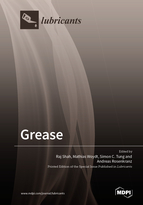Grease
A special issue of Lubricants (ISSN 2075-4442).
Deadline for manuscript submissions: closed (30 November 2021) | Viewed by 41653
Special Issue Editors
5. External Board of Advisors (Co-chair) at Tribology Minor Program in Deptartment of Mechanical Engineering, Auburn University, Auburn, AL, USA
Interests: friction; wear; oxidation; analytical instrumentation; tribology; bench testing techniques; greases
Special Issues, Collections and Topics in MDPI journals
Interests: ceramic composites; thin film coatings and thermally sprayed coatings; abrasive wear; lubricant formulations and tribo-testing including their dissemination into industrial applications
Special Issues, Collections and Topics in MDPI journals
Interests: automotive lubricants; driveline lubrication; industrial lubricants; EV/hybrid components; thermal management coolants; tribological performance testing; nanofluids; energy storage materials; fuel cell applications
Special Issues, Collections and Topics in MDPI journals
Interests: MXenes; nanocomposites; tribology
Special Issues, Collections and Topics in MDPI journals
Special Issue Information
Dear Colleagues,
Everybody has made use of “Grease” in their daily lives. The word “grease” originates from the early Latin word “crassus,” meaning fat. For our purposes and with respect to this Special Issue, we will be focusing on lubricating grease, essentially being eponymous with the name of the hosting journal Lubricants. According to ASTM, lubricating grease may be defined as “a solid-to-semi-fluid product of dispersed thickening agents in a liquid lubricant”. Other functional ingredients such anti-wear and extreme pressure additives may be included, with the overall goal to induce special properties/functionalities.
Grease is a very complex lubricant, and we have never had a Special Issue just focusing on this key product, and lubricating greases are often underrepresented in the technical literature. In the last few years, significant research progress on greases has been made, ranging from specific chemical formulation of greases for special applications to how grease interacts with various surfaces, tribological advances in grease properties, and new techniques for grease property measurements, etc. Recently, greases have also been evolving, as they are playing a key part in the lubrication of electric vehicles. We aim to select the top research avenues and papers worldwide related to lubricating greases in this compilation. This Special Issue wishes to be the first of its kind, and we plan to make this an annual exercise where our compendium is aimed at discussing the latest developments worldwide encompassing all areas related to greases.
Dr. Raj Shah
Dr. Mathias Woydt
Dr. Simon C. Tung
Prof. Dr. Andreas Rosenkranz
Guest Editors
Manuscript Submission Information
Manuscripts should be submitted online at www.mdpi.com by registering and logging in to this website. Once you are registered, click here to go to the submission form. Manuscripts can be submitted until the deadline. All submissions that pass pre-check are peer-reviewed. Accepted papers will be published continuously in the journal (as soon as accepted) and will be listed together on the special issue website. Research articles, review articles as well as short communications are invited. For planned papers, a title and short abstract (about 100 words) can be sent to the Editorial Office for announcement on this website.
Submitted manuscripts should not have been published previously, nor be under consideration for publication elsewhere (except conference proceedings papers). All manuscripts are thoroughly refereed through a single-blind peer-review process. A guide for authors and other relevant information for submission of manuscripts is available on the Instructions for Authors page. Lubricants is an international peer-reviewed open access monthly journal published by MDPI.
Please visit the Instructions for Authors page before submitting a manuscript. The Article Processing Charge (APC) for publication in this open access journal is 2600 CHF (Swiss Francs). Submitted papers should be well formatted and use good English. Authors may use MDPI's English editing service prior to publication or during author revisions.
Keywords
- grease
- tribology
- thickener
- ASTM
- ISO
- lubrication
- friction
- lithium
- bearings
- electric vehicles
- biodegradation
- tribometry
- additives
- antioxidants
- antiwear
- extreme pressure
Related Special Issue
- Grease II in Lubricants (8 articles)









